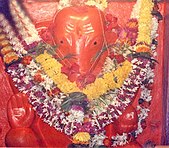| This article needs additional citations for verification. Please help improve this article by adding citations to reliable sources. Unsourced material may be challenged and removed. Find sources: "Varadvinayak" – news · newspapers · books · scholar · JSTOR (January 2021) (Learn how and when to remove this message) |
| Varadvinayak | |
|---|---|
| Religion | |
| Affiliation | Hinduism |
| District | Raigad district |
| Deity | Lord Ashtavinayak |
| Location | |
| Location | Mahad village situated in Khalapur taluka near Karjat and Khopoli |
| State | Maharashtra |
| Country | India |

Varadvinayak, also spelt as Varadavinayaka, is one of the Ashtavinayak temples of the Hindu deity Ganesha. It is located in Mahad village situated in Khalapur taluka near Karjat and Khopoli of Raigad District, Maharashtra, India. The temple was built (restored) by Peshwa General Ramji Mahadev Biwalkar in 1725AD.
Legend
Legend has it that the childless king, Bhima of Koudinyapur and his wife met the sage Vishwamitra while they had come to forest for penance. Vishwamitra gave the king a mantra (incantation) Ekashar Gajana Mantra to chant and thus his son and heir, prince Rukmaganda was born. Rukmaganda grew up into a beautiful young prince.
One day, on a hunting trip Rukmaganda stopped at the hermitage of Rishi Vachaknavi. The Rishi's wife, Mukunda, fell in love at the sight of the handsome prince and asked him to fulfill her desires. The virtuous prince flatly refused and left the ashram. Mukunda became very lovesick. Knowing her plight, King Indra took the form of Rukmaganda and made love to her. Mukunda became pregnant and gave birth to a son Gritsamada.
In time, when Gritsamada learned of the circumstances of his birth, he cursed his mother to become the unattractive, thorny berry-bearing "Bhor" plant. Mukunda in turn cursed Gritsamada, that a cruel rakshas (demon) will be born from him. Suddenly they both heard a heavenly voice saying, "Gritsamada is the son of Indra", leaving them both shocked, but too late to alter their respective curses. Mukunda was transformed into the Bhor plant. Gritsamada, ashamed and penitent, retreated to the Pushpak forest where he prayed for a reprieve to Lord Ganesh (Ganapati).
Lord Ganesha was pleased by Gritsamada's penance and offered him a boon that he will bear a son who would not be defeated by anybody other than Shankara (Shiva). Gritsamada asks Ganesh to bless the forest, so that any devotees who pray here will be successful, and also urged Ganesha to stay there permanently and asked for knowledge of Brahma. Gritsamada built a temple there and the Ganesha idol installed there is called Varadavinayaka. Today the forest is known as Bhadraka.
It is said that if the coconut received as prasad during Maghi Chaturthi is consumed, one will be blessed with a son. Hence the temple is especially full with devotees during Maghi Utsav.
The temple
The idol of this temple Varada Vinayak is a swayambu (self originated) and was found in the adjoining lake in an immersed position in 1690 AD. This temple is said to be built in 1725AD by Subhedar Ramji Mahadev Biwalkar. The temple premises are on one side of a beautiful pond. The idol of this temple faces the east and has his trunk turned to the left. There is an oil lamp in this shrine which is said to be burning continuously since 1892. This temple also has the idol of Mushika, Navagraha Devatas and Shivalinga. There are 4 elephant idols guarding the 4 sides of the temple. In this Ashta Vinayak Temple devotees can enter the Garbhagriha and pay their homage and respects to the idol personally. Devotees visit the Varadvinayak shrine throughout the year. During festivals like the Magha Chaturthi huge crowds can be seen in this temple.
See also
References
- "A glance at the significance of Ashtavinayak pilgrimage". punemirror.com. 4 September 2022. Retrieved 4 December 2022.
- "Ganesh Chaturthi 2022: गणेश चतुर्थी पर करिए महाराष्ट्र के इन 8 मंदिरों के दर्शन, जहां पर विराजमान हैं स्वयंभू गणपति बप्पा". Dainik Jagran (in Hindi). Retrieved 4 December 2022.
- Grewal, Royina (20 July 2009). Book of Ganesha. Penguin UK. ISBN 978-93-5118-091-3.
- Kundu, Mousumi. WeaverMag Volume 8 | November Edition | Monomousumi Services. Monomousumi Services.
- ^ ''Varad Vinayak Ganpati Mandir, Mahad: Varadvinayak, Varadavinayaka, is one of the Ashtavinayak temples of the Hindu deity Ganesha. It is located in Mahad village situated in Khalapur taluka near Karjat and Khopoli of Raigad District, Maharashtra, India.(Please note that Mahaad town is different than Mahad)The temple was built (restored) by Peshwa General Ramji Mahadev Biwalkar in 1725AD. The idol of this temple Varada Vinayak is a swayambu (self originated) and was found in the adjoining lake in an immersed position in 1690 AD. This temple is said to be built in 1725AD by Subhedar Ramji Mahadev Biwalkar. The temple premises are on one side of a beautiful pond. The idol of this temple faces the east and has his trunk turned to the left. There is an oil lamp in this shrine which is said to be burning continuously since 1892. Devotees visit the Varadvinayak shrine throughout the year. During festivals like the Magha Chaturthi huge crowds can be seen in this temple.'' SOCIO-ECONOMIC GROWTH OF TOURISM NEED FOR SUSTAINABLE DEVELOPMENT IN RAIGAD DISTRICT: A GEOGRAPHICAL ANALYSIS
- "जानिए चौथे अष्टविनायक वरदविनायक मंदिर की अनोखी कथा". Dainik Jagran (in Hindi). Retrieved 4 December 2022.
| Ganesha | ||
|---|---|---|
| Forms |  | |
| Worship | ||
| Ashtavinayaka Temples | ||
| Legends and Texts | ||
| Associated deities | ||
| See also | ||
Categories:

